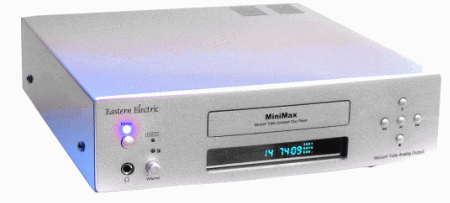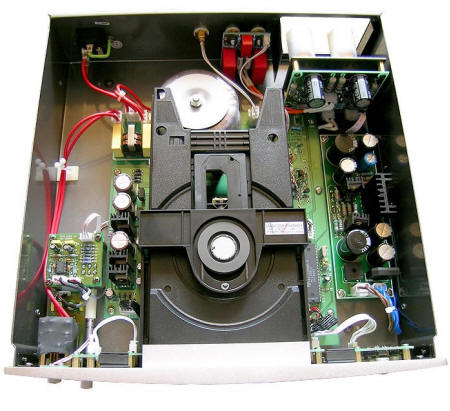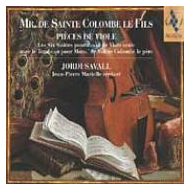You are reading the older HTML site
Positive Feedback
ISSUE
24
eastern electric
MiniMax CD player
as reviewed by Mike Peshkin

|
MIKE PESHKIN'S SYSTEM
LOUDSPEAKERS
ELECTRONICS
SOURCES
CABLES
ACCESSORIES
|
When I first heard the Eastern Electric MiniMax phono stage, I was astounded. There have been few pieces of equipment that excited me as much. In looks, sound, and every other parameter I could think of or ask for, I found the MiniMax mesmerizing, so when I found out that there was a CD player from Eastern Electric, I asked to review it. Once again, I was pleased beyond reason with its looks, and with its sound.
I have discussed the sonic differences between digital and analog playback with Bill Morningstar of Eastern Electric on several occasions. I believe that a comparison of digital and analog sound is a complete waste of time. I have come to the conclusion that they are different views of the same thing. That said, I must report that I prefer analog sound, but comparing the two is comparing apples to oranges. Sometimes I want an apple, sometimes I want an orange.
Because very little new music is available on vinyl, to not listen to digital is to refuse and dismiss music. Music is always growing, borrowing from the past, and forging into the future, so if you don't listen to anything new you are NOT a music lover. It’s a tough stance, I know, but sometimes ya just gotta tell it like it is!
One of the main reasons I wanted to listen to the Eastern Electric CD player was to hear—in my home, with my own equipment—how much digital playback had progressed since I purchased my Audio Alchemy CD player in the last century (I've wanted to write that phrase for years!). I was especially interested in the Eastern Electric player because it has a tube output stage, and I am mesmerized by tube sound. I love sound that some may viewed as overly warm. I want to enjoy the best playback that I can from well-recorded discs, whether they are 12-inch pieces of black vinyl or 5-inch discs of silver polycarbonate, but I also want to be able to enjoy less well-recorded discs. I don't want to hear the warts, or perhaps it is better to say that I don't want those warts spotlighted.
The Audio Alchemy is that type of performer, but it lacks the detail retrieval of the Eastern Electric player. The difference is not huge, but it is very positive. The Audio Alchemy was a giant killer in its day, and still holds its own when I am away from the reviewer's chair. It's great for parties, and great for falling asleep while listening to calming music in the evening. It still impresses audio folks! The MiniMax throws a wider and deeper soundstage, and the imaging is more precise, yet it still has that lushness I crave. The MiniMax surprised me by providing several things that I've learned to live without while listening to CDs. From the beginning of the digital era, I have felt that CDs couldn't get attack and decay correct. In fact, I believed that it was non-existent in digital playback. I was wrong! Need I say more?
Anyone living in a cold environment can tell you that 70 degrees Fahrenheit is warm—too warm if there's a lot of humidity in the air. But when it's really cold outside and the air in a home is drier than the Sonora desert, 70 degrees isn't warm enough (at least not for my arthritic bones). I have a micro-fiber blanket that I use while watching TV that keeps me quite warm if I'm cold but is light enough to throw off when I'm too warm. On our bed, we have an afghan that my wife's mother made that weighs approximately twelve-and-a-half tons. It is perfect for the job of keeping us warm and cozy, but sometimes we have to throw it off in the middle of the night. What does this have to do with CD players? The MiniMax is the micro fiber blanket. It is light, fast, and it warms my soul. The Audio Alchemy is the afghan. It is also warm, but sometimes presents the music in a heavy-handed manner. Both players sound good, but different.

The Eastern Electric MiniMax destroyed the Audio Alchemy in the Remote Control Beauty Awards—the Audio Alchemy's device is just a remote, while the MiniMax’s is a work of art. It weighs more than my Durango! It's cut from a bar of solid aluminum, and who says aluminum is light? I found it much easier to use than the Audio Alchemy remote. When I wanted to replay a certain track to listen for a particular sound, it was a breeze to punch the right buttons. I’ve NEVER been able to punch the right buttons on the Audio Alchemy remote, and I’ve hardly ever used it, but I enjoyed playing with the MiniMax's remote. The ten-year-old Audio Alchemy does a great job of delivering the music, but does not fulfill my audiophile goals, while the MiniMax meets all of my qualifications for a serious piece of hi-fi equipment.
And of course, I want it all! While I am sure that there are CD players that can easily outperform the MiniMax, I'm also sure that I can't afford them. A well-integrated system should make you want to listen to music, and I believe that every part of the chain is important—not just the sources, amplification, and speakers, but the wires, too. If the connections aren't good, if the interconnects don't match the equipment, the musical and audio experience suffers. During the time I had the MiniMax CD player, I was also listening to a pair of Luminous Audio Technology Silver Reference interconnects. (I was also sent a bi-wire set of speaker cables, but didn’t use them because my Infinity P-FR speakers only have one pair of binding posts.) I used the Luminous interconnects between the MiniMax CD player and my Anthem preamp. I used them when I drove the Infinities with the little Dared MP 5 integrated amp. I even hooked them up (along with my normal Silver Dragon ground wire) to the junction box of my JMW10 Memorial tonearm.
I had burned in the Luminous interconnects by using the Mobie burn-in device, which uses a higher voltage than interconnects will ever see in an audio system. If you haven't heard of this gem, you should find out about it and buy one! I am a Luddite and proud to call myself one, and didn't trust the Mobie even though it does exactly what it is supposed to do, so I set the MiniMax on repeat to add to the cables’ burn-in time. When I was satisfied that they (AND the MiniMax player AND the Dared MP 5) were ready to listen to, I played CD after CD, LP after LP, then more CDs, then more LPs, and I didn't stop there. I exchanged the Luminous cables for my Silver Dragons in every configuration I could imagine. At first I believed that the Luminous cables tromped my Silver Dragons, but when I changed back to the Dragons I realized that the Luminous cables rolled off the extreme highs. After changing back and forth with both CDs and LPs, I found that the Luminous Silver Reference cables had a richer tone and a bit more warmth, and if there's something I don’t need in my system, it’s more warmth! The highs also seemed a bit rolled off. With the Reference interconnects, the LP Blues Jam in Chicago Vol. 1 (Blue Horizon BH4803) gave me the "blues shivers," a name I give to the excitement that blues singers can incite. However, when I listened to Miles Davis' Bag's Groove (JVC XRCD Prestige 7109), the excitement was gone—until I put the Silver Dragons between the CD player and my preamp.
The Luminous Audio Silver Reference interconnects would be great in a cold and analytical system, but they didn't float my boat with any amplification that I tried. They had slightly more coherent soundstaging and imaging, but didn’t excite me. I don't blame the wire. Warm wire plus warm system equals hot sound (or something like that–I feel like Homer Simpson writing that). I took the Luminous cables to a friend's house to hear it in a system that is quite different from my own—Magneplanar 1.6 speakers driven by a Van Alstine Omega Star 440 HC. My friend uses MIT wire throughout his system, including Term 2 bi-wire speaker cables and MIT 330. His system revealed how great silver can sound. The Silver Reference cables between his Mapleknoll Monolith turntable and Anthem Pre1P (the same preamp as mine) didn't destroy the MIT cables, but given the choice, both of us would keep the Luminous Audio cables. In his system, the MIT cables softened the attack. Drums, cymbals, piano and strings revealed the Luminous Audio cables to be the better choice.
 Back at the ranch (my house), the MiniMax showed
itself to be a great tool for evaluating cables. When I put a pair of
homemade silver interconnects between the MiniMax and the Anthem preamp, I
heard the difference quite easily. Listening to the wonderful two-CD set
Pieces De Viole (Alia Vox AU9827), with Jordi Savall on viola, was an EVENT.
The MiniMax tromped what I have heard when listening to that recording on my
Audio Alchemy player. The differences were so severe that I wanted to cry,
and crying would be easy, since Savall's artistry was reproduced so
beautifully by the MiniMax. Every nuance of his playing was revealed. I
could almost touch the viola, reach down and feel the rosin that fell from
his bow. Such mastery—by Savall AND the MiniMax! This was the CD that made
me revise my belief that CDs cannot reproduce attack and decay correctly.
Back at the ranch (my house), the MiniMax showed
itself to be a great tool for evaluating cables. When I put a pair of
homemade silver interconnects between the MiniMax and the Anthem preamp, I
heard the difference quite easily. Listening to the wonderful two-CD set
Pieces De Viole (Alia Vox AU9827), with Jordi Savall on viola, was an EVENT.
The MiniMax tromped what I have heard when listening to that recording on my
Audio Alchemy player. The differences were so severe that I wanted to cry,
and crying would be easy, since Savall's artistry was reproduced so
beautifully by the MiniMax. Every nuance of his playing was revealed. I
could almost touch the viola, reach down and feel the rosin that fell from
his bow. Such mastery—by Savall AND the MiniMax! This was the CD that made
me revise my belief that CDs cannot reproduce attack and decay correctly.
Listening again and again to Bags Groove (I absolutely adore that CD!), I was mesmerized by the sound of Milt Jackson's vibes. Vibes can sound so weird when they are reproduced (or recorded) poorly, especially if the recording or playback doesn't reveal attack and decay. The bell-like sounds of the vibraphone filled the room, and the interplay between the musicians made me feel like I was at the recording venue. As I listened to recording after recording, I began (metaphorically) whipping myself for believing that digital sound would never come close to analog sound. I had never experienced a believable soundstage or rock-solid, three-dimensional imaging when listening to CDs, but on almost all of the discs I played—at least the well-recorded ones—images were quite dimensional, and the stage extended well outside of the speakers. I was thrilled!
 Tina Brooks'
Back to the Tracks (Blue Note
CDP724382173724) isn't a bad recording, but it surely isn't an audio
spectacular. Still, I could hear the snap and excitement of Brooks’
artistry. While I couldn't hear the keys clacking on his saxophone, do I
really have to hear that to enjoy his music? When I played the Kronos
Quartet's In Formation (Reference Recordings RR 9 CD) and the remarkable CD
transfer of Dorati Conducts Respighi (Mercury 4320073) I was rewarded with
wonderful sound and a very believable soundstage. In fact, in my notes on
the Kronos Quartet disc, I had a row of exclamation points after the words,
"Wow! What imaging!" I tried the CD of Eric Clapton Unplugged, listening for
what I heard when the LP and CD were released years ago. On the LP, as
Clapton taps his foot, you can hear the hollow sound of the raised stage. I
had never heard it when I played that CD on the Audio Alchemy, and sadly, it
was still missing when I played it through the MiniMax. Maybe there were two
different masters.
Tina Brooks'
Back to the Tracks (Blue Note
CDP724382173724) isn't a bad recording, but it surely isn't an audio
spectacular. Still, I could hear the snap and excitement of Brooks’
artistry. While I couldn't hear the keys clacking on his saxophone, do I
really have to hear that to enjoy his music? When I played the Kronos
Quartet's In Formation (Reference Recordings RR 9 CD) and the remarkable CD
transfer of Dorati Conducts Respighi (Mercury 4320073) I was rewarded with
wonderful sound and a very believable soundstage. In fact, in my notes on
the Kronos Quartet disc, I had a row of exclamation points after the words,
"Wow! What imaging!" I tried the CD of Eric Clapton Unplugged, listening for
what I heard when the LP and CD were released years ago. On the LP, as
Clapton taps his foot, you can hear the hollow sound of the raised stage. I
had never heard it when I played that CD on the Audio Alchemy, and sadly, it
was still missing when I played it through the MiniMax. Maybe there were two
different masters.
Is the Eastern Electric MiniMax CD player perfect? Nothing's perfect. I listened to both the LP and the CD of The Thelonious Monk Quartet with John Coltrane at Carnegie Hall, and was not surprised to once again hear the difference between analog and digital. However, if I didn't have the one to compare to the other, I would have been quite happy with the CD. I thought that the MiniMax was a bit bass-shy compared to the Audio Alchemy on the Monk/Coltrane CD, but the two players were in two different systems, so it was more of a feeling than a true comparison. I was not disappointed in any way with the bass response of the MiniMax. Listening to Janis Ian's Breaking Silence, another old favorite (for both music and sound), showed me that this CD player can correctly reproduce the sound of a woman's voice, but I was blown away by the sound of the bass guitar on the cut "Be There." So much for my feeling that the MiniMax is bass-shy.
I believe that you can't get the best unless you pay for the best, that money often does buy performance. The Eastern Electric MiniMax is a very affordable CD player that can possibly be bested by many higher-priced players, but I don’t think there are too many in its price range that will sound as beautiful. I’m not even certain that more expensive players will beat this one, as I haven't heard any in my home. Once again I have to ship something back that I'd love to keep. Ah, the pain of being a reviewer! Mike Peshkin
MiniMax CD player
Retail: $1099
Eastern
Electric
web address:
www.eeaudio.com
Morningstar
web address:
www.morningstaraudio.com
